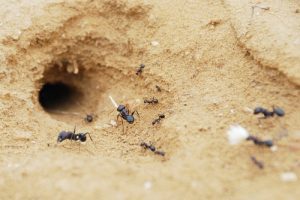A View of Life in an Ant Colony
By Chris Williams on April 17, 2012.
Q. I really like ants and I want to do a school report on the life of ants. Can you tell me how an ant nest operates? My mom said it was okay to get some help from pest experts as long as I use my own words.
A. Happy to help. The words here in italics are entomology terms that you should look up. As you probably already know, ants are called social insects because they live in a large cooperative group or nest called a colony. Individuals in a colony help each other out. Two or more generations overlap in the colony and the adults take care of the young ants. The colony operates under a division of labor or caste system which means that each individual in the colony has its own specialized job to do.
 Ant Queen –The queen is the “mom” for the colony. She starts the nest after her mating flight. She then sheds her wings, lays eggs, and cares for her first brood of young. Once this first group of future workers is mature, they take over the maintenance of the colony and care for the queen. She then becomes a large “egg-laying machine,” producing more workers. The queen is the largest member of the colony and may live for many years; she doesn’t leave the colony unless the colony is moving to a new location. Some ant colonies have more than one queen.
Ant Queen –The queen is the “mom” for the colony. She starts the nest after her mating flight. She then sheds her wings, lays eggs, and cares for her first brood of young. Once this first group of future workers is mature, they take over the maintenance of the colony and care for the queen. She then becomes a large “egg-laying machine,” producing more workers. The queen is the largest member of the colony and may live for many years; she doesn’t leave the colony unless the colony is moving to a new location. Some ant colonies have more than one queen.
Ant King –If the queen is the mom, then the king is the “dad” of the colony. However, he doesn’t take an active part in the colony. His sole purpose is to mate with the queen. He dies shortly afterward. The king is a large reproductive ant, but not as large as the queen. He has wings but doesn’t shed them like the queen.
Usually in spring or early summer, an ant colony that is at least a couple of years old will produce large numbers of winged forms called alates or swarmers. These are the young queens and kings that fly away from the parent colony to mate and start new colonies of their own.
Ant Workers –The smaller individual ants that you see running around and following trails and collecting dead insects are the workers. They are sterile, wingless female ants. The workers act as the food gatherers, the maintenance and construction crews, nursemaids for the eggs and larvae, and servants for the queen. In some ant colonies, workers specialize in their jobs and may be different sizes; this is called polymorphism. Normally though, there are just two sizes of workers, referred to as major workers and minor workers. When they are foraging, the workers swallow foods and return to the colony where they regurgitate (vomit up) the foods to feed the larvae, other workers, and the queen. This method of sharing food is called trophallaxis. Yucky, huh? One of the reasons that ant colonies are so successful is that everything is done for the good of the entire colony not for the good of the individual.
Here’s a great web site for kids interested in bugs, “PestWorld for Kids.” It has tons of stuff about insects, including more about ants, cool bug games, and there’s even a section on how to write a report on insects. Check it out at: http://www.pestworldforkids.org/index.html